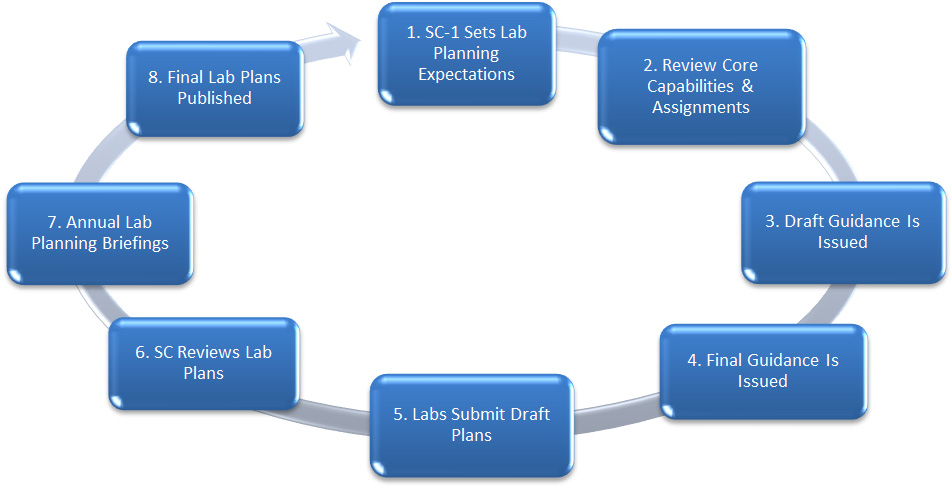Laboratory Planning Process
The Department of Energy (DOE) Office of Science (SC) is responsible for the effective stewardship of ten national laboratories. SC’s challenge is to ensure that these institutions are oriented to focus, individually and collectively, on achieving the DOE mission, that Government resources and support are allocated to ensure their long-term scientific and technical excellence, and that a proper balance exists among them between competition and collaboration.
Congress emphasized the importance of planning for the future of the laboratories in a report accompanying the Fiscal Year (FY) 2006 Energy and Water Development Appropriations Bill, in which it required DOE to produce business plans for each of the national laboratories. While this requirement does not exist today, SC has acknowledged the importance and benefits of conducting a laboratory planning process on an annual basis as an element of its stewardship responsibility for these institutions.
Each year, SC engages its laboratories in a strategic planning activity that asks the laboratory leadership teams to define a long-range vision for the future of their respective institutions and the science and technology they conduct on behalf of the Department. This information provides the starting point for a discussion between the SC leadership and the laboratory about each laboratory’s future directions, strengths and weaknesses, immediate and long-range challenges, and resource needs.
The Office of Laboratory Policy develops, manages, and coordinates implementation of the annual laboratory strategic planning process on behalf of the Director of the Office of Science, including preparation of instructions and annual laboratory policy and institutional guidance.
Office of Science’s Ten-Year Plans for the Science National Laboratories FY24
Laboratory Plan Format
Each winter, SC formulates planning guidance for its laboratories to use to develop the strategic ten-year plans. These plans consist of the following sections:
- Mission/Overview: This section, which is intended for a public audience, comprises of a top-level summary of the laboratory that covers everything from the history and location of the laboratory to a list of its current core capabilities and a profile of its staff.
- Lab-at-a-Glance: This section, which is intended for a public audience, outlines the laboratory’s major sources of funding and overall costs of operation and provides a snapshot of the laboratory’s human capital assets.
- Summary of Major Changes to Laboratory Core Capabilities: SC has identified seventeen categories of core capabilities that comprise the scientific and technological foundation of its national laboratories and has identified the existence of these capabilities across the SC complex. SC uses three criteria to define core capabilities. They must: 1) encompass a substantial combination of facilities and/or teams of people and/or equipment; 2) have a unique and/or world-leading component; and 3) be relevant to a discussion of the missions of the DOE, National Nuclear Security Administration (NNSA), and the Department of Homeland Security (DHS) missions. This section, which is intended for a public audience, provides an overview of a laboratory’s current core capabilities. These descriptions are intended to articulate the niche that each laboratory holds in the SC complex relative to the other SC laboratories so as to easily distinguish these institutions from one another.
- Science and Technology Strategy for the Future/Major Initiatives: This section provides the basis for an in-depth discussion between the laboratory and the SC leadership about the laboratory’s vision for the future of the laboratory. This discussion occurs in the context of a complete vision for a healthy, world-class laboratory and the resource needs and risks associated with accomplishing that vision, including campus expansions/improvements. With the exception of a two-paragraph summary, this section is for internal use only.
- Technology Transitions, Commercialization, and Partnership Strategy: This section, which is for internal use only, asks the laboratories to communicate their overall strategy and forward-looking vision for the laboratory’s technology transfer and Strategic Partnerships Projects (SPP) activities. The laboratory should articulate how Cooperative Research and Development Agreement (CRADA), Agreements for Commercialization Technology (ACT), and SPP contribute to and strengthen the laboratory’s core capabilities; align with and aid in accomplishing missions of the DOE; further the commercialization of technology; and demonstrate how the activities are integrated into the laboratory’s strategic planning efforts. As an appendix to the laboratory plan, SC also asks the laboratories to provide descriptions of their ongoing SPP activities and a SPP funding level ceiling request for the next fiscal year.
- Infrastructure: This section addresses mission readiness of laboratory facilities to support mission goals by identifying gaps and plans to fill those gaps. This section should also make clear the connection between the laboratory’s Mission Readiness plans and the laboratory’s science and technology drivers and core capabilities. The information provides the basis for a discussion about the laboratory’s current infrastructure, the scope of its infrastructure needs, and the priority associated with those needs. This section, with the exception of the Computing Infrastructure section, is intended for a public audience.
- Human Resources: This section, which is for internal use only, requests the information needed to elucidate the laboratory’s perspective on the gap between its current human capital situation and an optimal one, the obstacles it is encountering with respect to developing a mission-ready workforce, and the actions it is taking to address these obstacles.
- Cost of Doing Business: This section, for internal use only, provides the basis for a discussion with DOE about the cost of doing business at the laboratory, including the strategy and approach used for cost management at the laboratory, the drivers (internal and external) that are affecting the cost of doing business at the laboratory, and the trade-offs and choices the laboratory is making with respect to spending their limited discretionary resources.
Annual Planning Process



